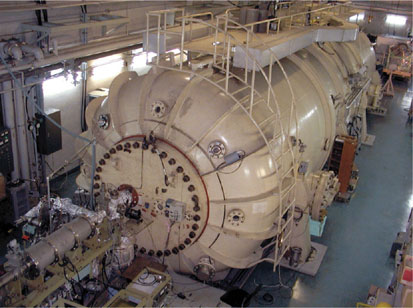| Å@ |
Prof. Kenshi Sagara
Department of Physics, Faculty of Science |
In the sun and massive stars, hydrogen
is burning and helium is increasing by nuclear fusion reactions.
After hydrogen is burnt out, helium burning takes places in massive
stars, and 12C and 16O, which are important for organisms, are produced.
In heavier stars, 12C and 16O begin to burn and supernovae occur. Our galaxy
has two supernovae in 100 years on the average.
In the helium burning, 4He+12C->16O+g reaction plays a very important role in
determining the ratio of 12C/16O and the scenario to proceed to supernova.
Many efforts to measure the 4He+12C->16O+g reaction rate have been made for over 30
years in the world, however, the reaction rate is still unknown.
The measurement is extremely difficult because the reaction rate
is small and very few 16O's are produced.
The measurement is planned at the Kyushu
University tandem accelerator laboratory (Fig.1). For this experiment,
new methods have been invented.
1) 12C beam intensity was 1,000 times increased by
a new idea of accel-decel strong focusing and by a new gas stripper
that has the largest aperture in the world.
2) Target 4He gas is confined in vacuum without foils by
a new idea of blowing-in.
3) Produced 16O's are separated from 12C
beam and focused a recoil mass separator.
4) Continuum 12C beam was transformed to a pulsed beam to reduce
backgrounds.
At present, the background level is
10-14 of the 12C beam. When the level reaches 10-15
we will start the measurement, and we will complete it when the
level is reduced to 10-19. A German group is making similar efforts.
In a few years, the 4He+12C->16O+g reaction rate will be measured accurately
at Kyushu University and in Germany.

Fig.1 Kyushu University tandem
accelerator (4m in diam.)

|

